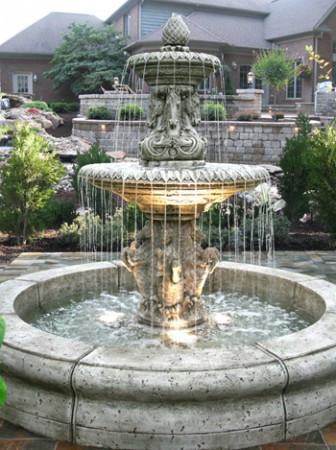Can Outdoor Fountains Be Used Indoors?
Can your outdoor fountain work well inside your home? This is a common question for many seeking to enhance indoor aesthetics.
Yes, outdoor fountains can be used indoors, but with some considerations. They need adequate space and proper ventilation to manage humidity and must fit the interior design. Ensuring these factors can smooth the transition and benefit indoor air quality and ambiance.
We must be mindful of the intended environment for these fountains, as using an outdoor fountain inside could pose risks due to oversized proportions, potential moisture damage, and inadequate electrical safeguards for indoor use. Understanding these distinctions helps us decide where to place each type of fountain best.
Understanding Fountains
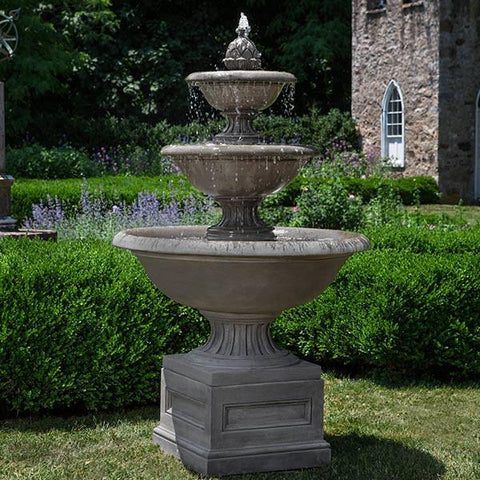
When considering water fountains, we look at diverse features that serve aesthetic and functional purposes. Fountains can be broadly categorized into two types: indoor and outdoor fountains. Each type is designed with specific environments and uses in mind.
Indoor fountains are typically smaller and more delicate. They're designed to fit within the controlled climate of an interior space, often made from materials such as ceramics, glass, or lightweight metals. The soothing sound of water from an indoor fountain can create a peaceful ambiance for places such as homes or offices.
On the other hand, outdoor fountains are built to endure the elements. These are often cast in heavy-duty materials such as:
- Stone
- Concrete
- Fiberglass
- Metal
This robust construction ensures they can withstand varying weather conditions, from freezing to scorching heat. Outdoor fountains are likely to have features to protect their electrical components, such as:
- UL-approved grounding plugs
- Shrouds for light protection
It's important to note that the interchange of these fountains could be more practical due to their construction, purpose, and material differences. An outdoor fountain placed indoors would not only be overwhelming in size but could also pose moisture issues. Conversely, an indoor fountain lacks the durability to survive outdoors. Therefore, each fountain type serves its niche, enhancing its environment with beauty and the mesmerizing sound of flowing water.
Design and Aesthetic Considerations
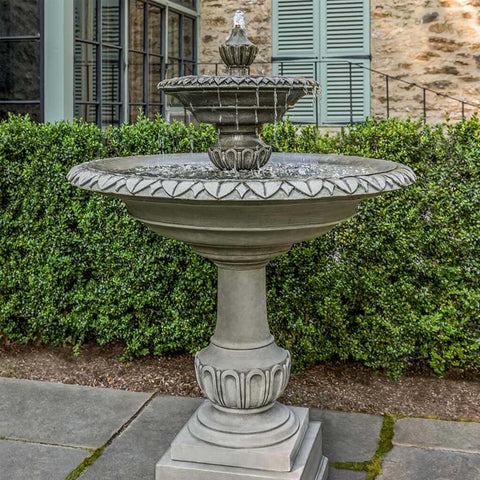
Our focus on design and aesthetics is paramount when considering repurposing outdoor fountains for indoor use. We need to ensure that the fountain complements indoor environments without compromising the stylistic integrity of the space.
Styles and Materials
Outdoor fountains come in various styles, from classical tiered designs to modern sculptural pieces. For indoor use, we typically select materials that harmonize with indoor decor—natural stone, glass, or metals like copper that patina elegantly resonate with indoor aesthetics. The material should match the style and suit the indoor climate without causing excessive humidity.
- Classic Styles: Tiered and pedestal fountains made of marble or granite
- Modern Styles: Sleek designs with stainless steel or glass features
- Rustic Styles: Simpler, organic shapes, often in cast stone or pottery
Size and Scale
Ensuring the fountain is of an appropriate size and scale is essential for indoor use. A fountain that is too large can overwhelm a space, whereas one that is too small may seem insignificant. We measure the room and consider the spatial dynamics to select a fountain that serves as an artistic centerpiece without disrupting the functional flow of the area.
- Ideal Fountain Dimensions (for medium-sized rooms):
- Height: 5-6 feet
- Width: 3-4 feet
Color and Lighting Effects
The color of the fountain should complement the interior palette. We often opt for neutral shades that reinforce the existing color scheme. Accentuating fountains with LED light can create a focal point and enhance the visual impact, casting reflections and shadows that amplify water's and design's beauty.
- Natural Tones: Beiges, browns, and greens tie in with most color schemes
- LED Lighting: Subtle, warm, or multicolored to accentuate the water flow
By carefully considering styles, materials, size, scale, colors, and lighting, we can tastefully incorporate an outdoor fountain into indoor spaces, adding a unique and tranquil design element.
Indoor Vs. Outdoor Differences
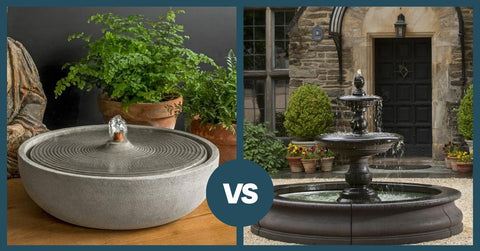
When considering the placement of fountains, we must weigh the important contrasts in environmental impact, construction, and maintenance. Each category highlights why indoor and outdoor fountains serve different purposes and are not universally interchangeable.
Environmental Impact
Outdoor fountains are designed to bravely face environmental stressors such as UV exposure, inclement weather, and fluctuating temperatures, which they tackle with robust materials like stone or metal. The comparably serene indoor environment needs to have the harsh elements of nature. Thus, indoor fountains are not built to combat weather-related challenges, making them unsuitable for outdoor use, where they might fall prey to humidity or water damage.
Construction and Durability
In terms of construction, outdoor fountains often boast larger dimensions and are constructed with durability to resist rusting and erosion. In stark contrast, indoor fountains are crafted with sleeker designs and smaller proportions, prioritizing aesthetics and a gentle water flow that prevents any splash-related damage to surrounding indoor surfaces.
Installation and Maintenance Requirements
Installing outdoor fountains requires securing them against environmental hazards and ensuring grounding measures are in place to prevent electrical mishaps. Maintenance for outdoor fountains may be less frequent due to stable water conditions compared to indoors. Meanwhile, indoor fountains necessitate meticulous attention to prevent mold and algae with frequent water changes and cleaning routines to maintain the clarity and hygiene of the water they cycle through their more delicate mechanisms.
Considerations Before Bringing an Outdoor Fountain Inside
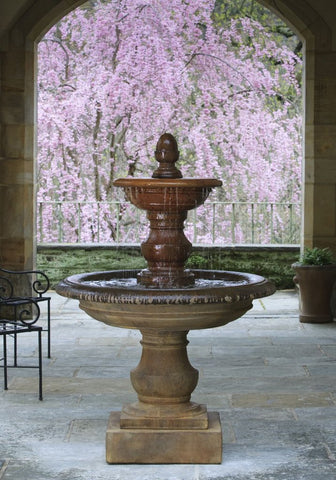
When we consider incorporating an outdoor fountain into an indoor space, we must consider several factors to ensure the transition is successful. Here are the key aspects to weigh in on:
Assessing the Space:
We need to measure the room where the fountain will be placed, ensuring the ceiling is high enough to accommodate any vertical design elements. The area must be spacious enough to fit the fountain and maintain a comfortable distance for safe movement.
Planning for Water Damage Prevention:
An outdoor fountain brought indoors requires us to lay down waterproof mats or bases to protect our flooring from potential water damage. This is crucial because water can spill or splash outside the fountain's basin.
Humidity Considerations:
We should also account for the change in humidity levels that a fountain can introduce to an indoor environment. A substantial body of water continuously running can significantly increase indoor humidity, potentially affecting wooden furniture and other sensitive decor. We must monitor and regulate indoor moisture to maintain a balanced atmosphere.
By addressing these considerations, we ensure that our indoor space can accommodate an outdoor fountain without adverse effects. Our goal is to achieve aesthetic enhancement while preserving the integrity of our interior environment.
Selection of Indoor Fountains
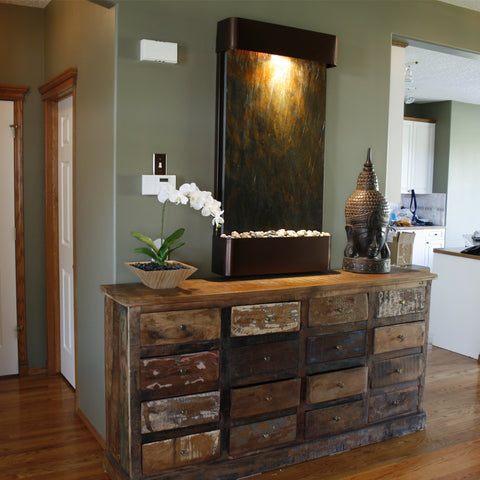
In our selection of indoor fountains, we prioritize materials that suit the indoor environment and focus on designs that enhance the aesthetic appeal of interior decor.
Material Choices for Indoor Use
When it comes to indoor fountains, we choose materials that harmonize with the typical conditions of an interior space. The following are some preferred materials for indoor fountains:
- Glass: A modern and clean look that allows light to pass and reflect, creating a brightening effect.
- Metal: Ideal for sleek and contemporary designs, metal fountains are durable and can come in various finishes.
- Stone: Providing a natural and timeless appearance, stone fountains create a sense of grounding in a space.
- Fiberglass: A versatile and lightweight option, fiberglass can mimic the appearance of heavier materials like stone or concrete but is more accessible to move.
- Concrete: While heavier, concrete can be used for bold, statement-making fountains with an industrial touch.
- Wood: Although less common due to the potential for water damage, certain treated woods can offer a warm and organic element to a fountain.
We ensure that the materials we select for indoor fountains are aesthetically pleasing and practically suited to the reduced wear and internal conditions of homes and offices.
Enhancing Interior Decor
Our indoor fountains are chosen for their ability to complement and elevate a space's decor.
- Design Alignment: We consider the existing decor style and recommend fountains with designs that complement or accentuate the theme—minimalist, traditional, or eclectic.
- Proportion: It is crucial to match the size of the fountain with the room's scale. A fountain should be a focal point without overwhelming the space.
- Color Palette: For a cohesive look, we advise on color schemes that coordinate with the room, whether it's picking up on accent colors or harmonizing with the overall palette.
- Sensory Experience: Besides visual appeal, the sound of the fountain should blend with the desired ambiance of the room— a gentle flow for relaxation or a lively cascade to energize the space.
In crafting the interior environment, we seamlessly integrate the fountain into the decor, ensuring it enhances the visual and acoustic experience.
Outdoor Fountain Features
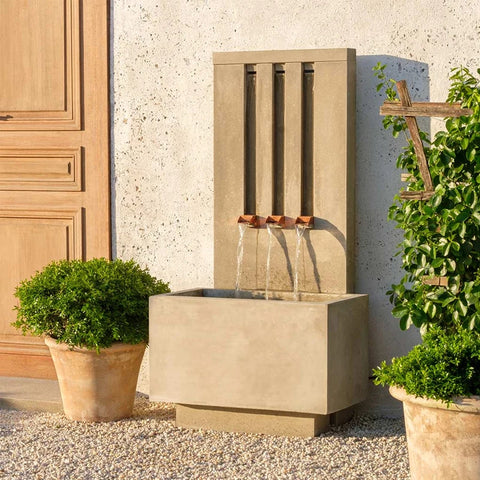
We understand that outdoor fountains must be durable and adaptable to various power sources to thrive in natural settings.
Weather Resistance and Seasonal Care
Outdoor fountains are exposed to various weather conditions, making resistance to elements like rain, snow, and wind integral. These fountains are typically constructed from materials that withstand seasonal changes without deteriorating. For instance, resin casts, concrete, or stone are common in outdoor fountain manufacture due to their longevity and hardiness. Seasonal care is crucial for maintaining an outdoor fountain's integrity. It's essential to prevent water from freezing in colder climates, as ice formation can cause cracks and damage. Regular cleaning is also necessary to prevent clogging from natural debris and ensure a safe environment for birds often visiting garden fountains.
Power Options for Outdoor Placement
Outdoor fountains require a power source to operate their water pumps. Power options include:
- Solar-powered systems: These are eco-friendly and suitable for gardens with ample sunlight. Solar panels harness the sun's energy, making these fountains independent of electrical outlets and reducing energy costs.
- Hardwired electrical systems: A fountain might be the best option for consistent and reliable power. Installation usually requires professional assistance to ensure safety and adherence to local building codes but offers uninterrupted fountain operation.
Considering these features and taking proper care, our outdoor fountains continue to be a captivating centerpiece in any garden setting.
Challenges of Using Outdoor Fountains Indoors
When we consider integrating outdoor fountains within indoor spaces, it's critical to understand the constraints and potential pitfalls associated with their usage.
Splash and Water Spill Concerns: One of the main issues arises from the design of outdoor fountains, which often prioritize containing splash differently than indoor fountains. Our concern here is twofold:
- Surface Damage: Unchecked water spray can harm various indoor surfaces. For instance:
- Carpets may become damp and potentially develop mold or mildew.
- Wooden flooring could warp, swell, or stain when exposed to water.
- Furniture near the fountain might suffer water damage over time.
We recommend carefully assessing the fountain's splash radius and planning protective measures to mitigate such risks.
Size and Scale Considerations: Another challenge stems from outdoor fountains' sheer size and scale. They are typically more robust and expansive to complement outdoor environments, which presents issues:
- Spatial Requirements: Our indoor areas often can only accommodate the large footprint of outdoor fountains with significant alterations.
- Practicality: Even if space is available, the fountain may overpower the room aesthetically or obstruct the flow of movement.
Given these challenges, we must evaluate indoor spaces thoroughly to ascertain whether they can realistically and safely house an outdoor fountain.
Integrating Fountains Into Your Space
When we incorporate fountains into our indoor or outdoor spaces, we focus on finding the optimal location, harmonizing them with surrounding garden elements, and selecting wall fountains that accentuate our design ethos.
Choosing the Right Location
To integrate a fountain seamlessly, selecting a location that establishes the fountain as a focal point but does not disrupt the flow of the space is essential. We look for an area with enough clearance to handle splashes and humidity. Outdoors, a fountain thrives as a central feature in a garden or near a pool, where it is both visually striking and functional.
Complementary Garden Elements
We ensure the fountain complements existing designs and elements in a garden setting. We create cohesion by:
- Pairing Fountains with Ponds and Pools: A fountain aids in aerating water bodies, contributing to a healthier garden environment.
- Vegetation and Lighting: The strategic placement of plants and lights can emphasize the fountain, enhancing its role in our overall garden design.
Wall Fountains and Design
Wall fountains are an artistic element that can be incorporated inside and outside. Here are specifics on wall fountain integration:
- Indoor Wall Fountains: We prefer walls in common areas where a fountain can be easily admired and doesn't cause moisture issues.
- Outdoor Wall Fountains: We opt for walls adjacent to patios or decks, providing visibility and auditory enjoyment without consuming valuable ground space.
Alternatives and Solutions
When we consider whether to use outdoor fountains indoors, it's essential to explore alternatives and solutions that can satisfy our aesthetic and practical requirements without compromising the fountain's functionality or the integrity of our indoor spaces.
Indoor Fountains Designed with an Outdoor Essence
Indoor fountains that capture the robust look of outdoor fountains but are specifically tailored for indoor use are available. These fountains incorporate elements that prevent water damage to floors and furniture, maintain a proper water flow rate, and reduce water evaporation.
- Protective Design: Water-resistant materials to mitigate damage and wear from indoor conditions.
- Style: Crafted to echo the grandeur or simplicity of outdoor designs.
Customized Outdoor Fountains for Indoor Use
We can also consider modifying an outdoor fountain to suit indoor environments. Here are key customizations we can apply:
- Splash Reduction: Adjust the water pump to lower the flow rate, minimizing splash.
- Size and Scale: Choosing or altering a fountain to fit the scale of the indoor space.
By taking these actions, we ensure that the chosen water feature will harmoniously blend with indoor living areas, offering the tranquility of an outdoor fountain without the associated risks.
Care and Maintenance
In adapting outdoor fountains for indoor use, we emphasize consistent maintenance to preserve aesthetics and function. Our focus is on routine cleaning coupled with prompt algae and debris management.
Routine Cleaning and Upkeep
We advocate for regular cleaning to ensure our fountain operates smoothly. This involves:
- Weekly Checks: Inspect the fountain for visible signs of dirt and grime.
- Monthly Cleansing: Our approach includes draining and refilling the fountain to remove accumulated debris.
- The Right Tools: We use soft cloths and non-abrasive sponges to prevent scratches during cleaning.
For components like the pump, delicate handling is crucial. We disassemble it carefully, wiping away dirt and ensuring its cover and interior components are clean.
Handling Algae and Debris
Effectively managing algae and debris prolongs our fountain's life and performance. Here's our routine:
- Algae Combat: We treat water with eco-friendly algae removers that are safe for pets and wildlife.
- Debris Removal: Leaves and other organic matter are promptly removed to prevent clogs.
- Preventive Measures: We prevent debris accumulation by situating the fountain away from trees and using a protective cover when not in use.
By prioritizing these care practices, we enhance our indoor fountain experience while minimizing the need for repairs.
Conclusion
We've outlined the differences between outdoor and indoor fountains, noting that outdoor fountains are built with durable materials to withstand harsh conditions, making them generally unsuitable for indoor use. Transferring an outdoor fountain indoors involves considering size, moisture, and safety hazards.
Before moving an outdoor fountain inside, it's crucial to consult with experts to ensure the move doesn't affect the fountain's aesthetics, safety, or longevity.
If you're considering such a transition, we advise seeking professional advice to carefully evaluate all implications and maintain a functional and harmonious space.
Frequently Asked Questions
Adapting an outdoor fountain for indoor use raises several practical concerns. To address these, we've outlined the most pressing questions and provided clear answers to ensure a smooth transition and optimal operation.
What adaptations are needed to use an outdoor fountain indoors?
Outdoor fountains may need modifications to the power connection to ensure they are safe for indoor use, as outdoor models typically have grounding plugs suitable for outdoor moisture conditions. We also recommend checking if the size and design of the outdoor fountain are appropriate for indoor spaces.
How does the maintenance of indoor water fountains compare to outdoor fountains?
Indoor fountains generally require less maintenance since they're not exposed to natural elements like dirt, leaves, and weather conditions that outdoor fountains contend with. However, regular cleaning and monitoring of water levels and pump functionality are essential for indoor fountains to prevent buildup and maintain hygiene.
What considerations should be considered regarding the noise level of indoor water fountains?
The acoustics of indoor settings amplify sounds, so a fountain's noise level may seem louder inside. Before bringing an outdoor fountain indoors, assess its sound output to ensure it is suitable for the indoor environment and does not create undue noise.
Are there benefits to having a water fountain inside the home?
Indoor water fountains act as natural humidifiers, adding moisture to dry interiors. They can also serve as dynamic focal points that enhance a home's aesthetic value and ambiance.
What type of water should be used in indoor fountains to ensure proper function and hygiene?
For indoor fountains, we recommend using distilled water to keep mineral buildup and bacterial growth to a minimum. It helps maintain the fountain's cleanliness and ensures the pump's longevity.
How does continuous operation affect outdoor fountains used indoors in terms of safety and maintenance?
Continuous indoor operation of outdoor fountains necessitates vigilant monitoring for electrical safety and proper water circulation. Regular checks of the pump, electrical components, and water quality are imperative to prevent hazards and ensure the fountain's durability.
